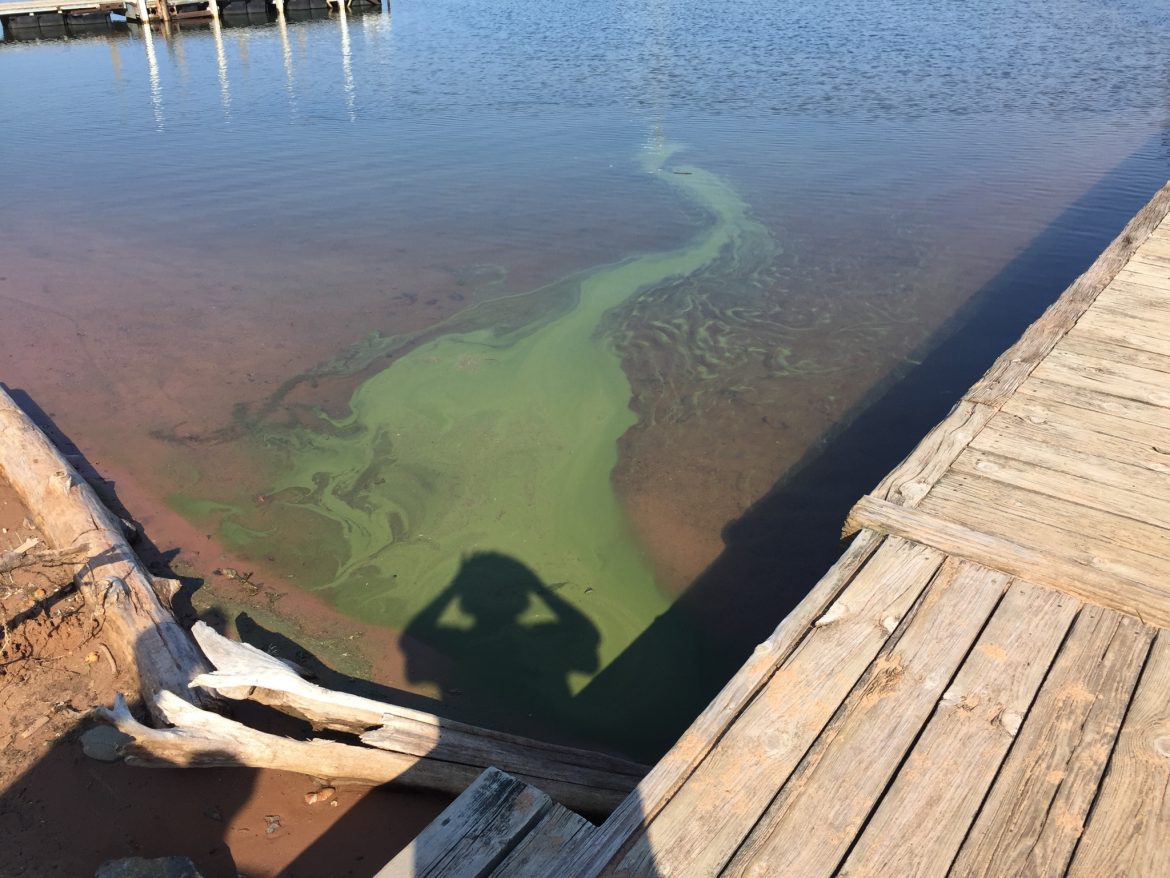
Algal blooms, like the one pictured here, have increased in the western arm of Lake Superior. Image: Brenda Lafrancois, National Park Service
By Anna Barnes
The Wisconsin Department of Natural Resources is banking on public oversight of the largest Great Lake to help gauge the threat of increasingly common algal blooms.
Blue-green algae, also known as cyanobacteria, can produce toxins that pose a danger to public health, said Kait Reinl, research coordinator at the National Oceanic and Atmospheric Administration’s Lake Superior National Estuarine Reserve in Superior, Wisconsin. Symptoms from exposure include stomach cramps, diarrhea, vomiting, headache, muscle weakness, fever and difficulty breathing, according to the Wisconsin DNR. Pets and children are particularly at risk.
“The reason we specifically call out children and pets is because they’re pretty indiscriminate about the water that they’re inhaling or swallowing, and that’s really where the biggest risk lies,” Reinl said.
As of Sept. 9 the Wisconsin DNR this year has received 195 reports of algae on lakes and rivers throughout the state, compared to 178 reports in 2023, Wisconsin Public Radio reported.
Algae are a natural part of the Great Lakes ecosystem and, through photosynthesis, produce much of the oxygen people breathe, she said.
“They are not inherently bad,” Reinl said, “It’s just that when they’re growing in abundance and in the cases where toxins are being produced, that’s when we start to see issues with degradation of environmental health or the posing of a public health risk.”
But cyanobacteria blooms are not normal for Lake Superior, Reinl said. Algae outbreaks tend to occur in warm water loaded with nutrients. Superior is nutrient-poor and the coldest of the Great Lakes, but warming temperatures and increased flooding have overridden its natural barrier against algal blooms. The lake’s ice cover last winter was among the smallest ever recorded, according to NOAA.
Harmful algae have so far been concentrated in the western arm of Lake Superior, according to NOAA. The public should watch out for tiny green blotches and avoid swimming near them.
Wisconsin’s DNR is asking the public to use a google form to report sightings and gather photos of these blue-green algae blooms, or to report them in an email to DNRHABS@wisconsin.gov.
People in Ontario who observe algae blooms on Lake Superior can report them online. Michigan and Minnesota also encourage the public to report blooms.

The Lake Superior National Estuarine Reserve made a flier to assist the public in reporting algal blooms. Image: Lake Superior National Estuarine Reserve
“There’s not really much that can be done in terms of neutralizing the toxin,” Reinl said. Researchers are working on better tools for assessing and managing blooms but the reporting form is the best they have for now, she said.
The DNR stops its seasonal beach monitoring after Labor Day, but algal blooms may continue beyond that point. Lake Superior is also much too large for agencies to monitor without help from the public, said Gina LaLiberte, the statewide harmful algal bloom coordinator for the department.
“It’s hard to cover that much shoreline,” LaLiberte said. “One of the biggest challenges is that these blooms are out in open water. They’re very short-lived and we need to know about them as soon as possible to coordinate someone getting out to grab a sample.”
Algal blooms are more commonly associated with Lake Erie, whose watershed is heavily agricultural. Precipitation often washes fertilizer and manure off of those farms and into waterways that feed the lake, which gives algal blooms the nutrients they need to grow, according to Alliance for the Great Lakes. The blooms also occur on many inland lakes.
Lake Superior’s algae outbreaks are, so far, much smaller than those that occur regularly in Lake Erie. In late summer, blooms on the shallower, warmer lake can cover several hundred square miles, while those reported in Lake Superior haven’t remained long enough to measure, according to NOAA.
“We don’t have a highly agriculturally dominated watershed, but even just a forested landscape has nutrients in it, so when we get these big flood events that washes a bunch of sediment into the water, the ecosystem responds to that,” Reinl said.
The first significant blue-green algae bloom spotted in Lake Superior was in 2012. It formed after significant flooding hit the Twin Ports area of Duluth, Minnesota, and Superior, Wisconsin, LaLiberte said. She has some ideas about why less developed areas are beginning to experience more blooms.
“Maybe there were some cyanobacteria in inland lakes that then got washed out into Lake Superior that then started to grow more in response,” LaLiberte said.
As temperatures warm, the lake could see worsening algae problems, she said. For now, spreading awareness of the danger to the public is the most important thing, she added.
“Especially for visitors it’s kind of challenging because they are coming, in some cases, from all over the world to visit Lake Superior,” she said.
*Correction: Due to an editing error, an earlier version of this story said that the numbers of reports received by the Wisconsin DNR in 2024 and 2023 were for algae in Lake Superior, rather than in lakes and rivers throughout the state. The story has been edited to reflect that change.
